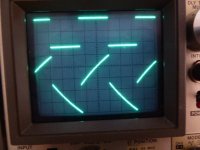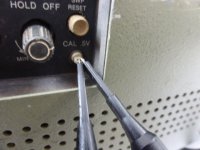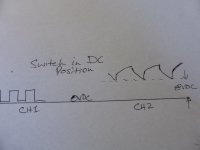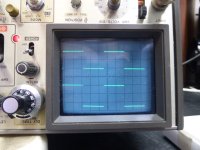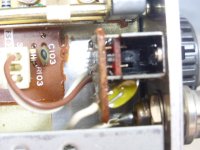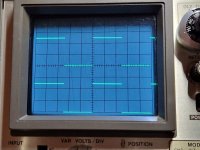Hello VCFers
I'm a retired serviceman from the scientific instrument field.
I have a seldom used portable Hitachi V-509 CRO which I find, after a long period of dormancy, has a Ch2 vertical problem.
This CRO was seldom needed but always carried into the field so has done a lot of miles in my service vehicle and become dusty and cosmetically, a little wanting.
I can't recall how long ago I used 2 channels but it would have been years ago (I have a Kikusui 60MHz bench CRO so that the infrequent needs was supplied by it).
The attached waveforms are generated by the 0.5V square wave, in-built cal signal with a serviceable X1 probe connected to it and each channel.
Both channels are set to 0.2V/div
Ch1 (upper, squarish trace) is barely OK but Ch2 (lower trace) is unusable.
Save a couple of DVMs and the CROs, I have no test equipment, virtually none of that called upon by the Hitachi V-509 Service Manual.
I'm looking for any guidance before I take off the covers.
Thanks in anticipation.
Roj.
I'm a retired serviceman from the scientific instrument field.
I have a seldom used portable Hitachi V-509 CRO which I find, after a long period of dormancy, has a Ch2 vertical problem.
This CRO was seldom needed but always carried into the field so has done a lot of miles in my service vehicle and become dusty and cosmetically, a little wanting.
I can't recall how long ago I used 2 channels but it would have been years ago (I have a Kikusui 60MHz bench CRO so that the infrequent needs was supplied by it).
The attached waveforms are generated by the 0.5V square wave, in-built cal signal with a serviceable X1 probe connected to it and each channel.
Both channels are set to 0.2V/div
Ch1 (upper, squarish trace) is barely OK but Ch2 (lower trace) is unusable.
Save a couple of DVMs and the CROs, I have no test equipment, virtually none of that called upon by the Hitachi V-509 Service Manual.
I'm looking for any guidance before I take off the covers.
Thanks in anticipation.
Roj.

